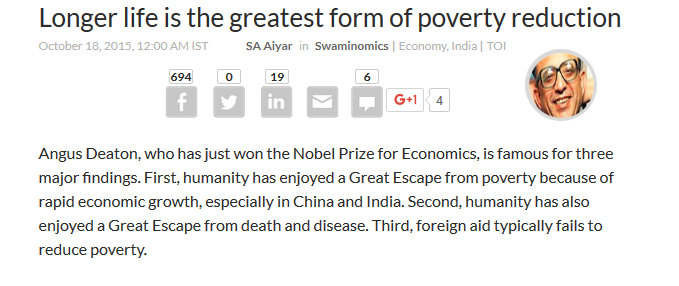Angus Deaton, who has just won the Nobel Prize for Economics, is famous for three major findings. First, humanity has enjoyed a Great Escape from poverty because of rapid economic growth, especially in China and India. Second, humanity has also enjoyed a Great Escape from death and disease. Third, foreign aid typically fails to reduce poverty.
Let me focus on the Great Escape from death. India has witnessed heated arguments on how much consumption should determine India’s poverty line. Yet, arguably, longer life is the greatest sort of poverty reduction. You cannot measure the value of extending life, yet nothing is more precious. In some countries, 90% of lifetime health spending occurs in the last year of a person’s life.
Indian poverty is down to 21% by government estimates, and 12% by the World Bank’s poverty line. It would have been almost zero had India followed the outward-looking, market-friendly policies of the Asian tigers. Economic reforms enabled 138 million to rise above the poverty line between 2004 and 2011.
Improved longevity helped even more. Since Independence, life expectancy is up from 32 years to 68.5 years. Infant mortality is down from 161 per thousand births to 40. The total death rate is down from 25.5 per thousand to barely 7. These are huge improvements. Yet they lag well behind achievements in other countries. The Great Escape needs to become a Greater Escape.
People willingly exhaust lifetime savings to gain a few more years of life. Roti, kapda and makan matter a lot, but life and death matter more. If people live 20 years longer, children are saved from early death, and mothers are saved from maternal death, that’s worth more than all government subsidies for roti, kapda and makan.
Per capita consumption is often used to measure poverty by the media and analysts, but can be utterly misleading. I crossed swords with Arnab Goswami some years ago when an NSSO survey showed that 138 million people had been raised above the official poverty line, which was then around Rs 5,000 per month for an urban family of five.
Many Delhiwallahs paid their servants less than that. But Arnab declared it was impossible to live on so little. His mathematical trick was to translate monthly family consumption into a daily rate of Rs 33 per person. Arnab declared that nobody could eat properly at Delhi dhabas on so little.
I had pointed out in a column in 2012 that the official poverty line was based not on a middle-class diet but on earning just enough to consume 2,000 calories/day. The truly poor ate dal-roti. A person without a ration card could, in the open market, buy 400 grams of wheat and 100 grams of chana dal — which would provide 2,000 calories — for Rs 12.50. With subsidized grain, available to most though not all poor folk, the cost would be less than half as much. The notion that all poor people, including babies, eat at dhabas is a TV fantasy. Families cook at home.
The fantasy becomes farcical if one adjusts for Deaton’s emphasis on the high value of life. Suppose a childless working couple earns Rs 5,000 per month. That equals Rs 66 per day per person, making Arnab happy. Next, suppose the couple has twins. The parents will be delighted. But Arnab’s calculations will show consumption falling to Rs 33 per capita, so the births are actually a tragedy.
Next, suppose the twins die of disease. The couple will regard this as a terrible tragedy. But Arnab’s calculation will show that the per capita consumption has doubled, so the death of the kids is a godsend. Lesson: per capita calculations are farcical when they ignore the value of life.
How best can lives be saved? Dan Spears’ pioneering work shows that open defecation is a major cause of disease, death and stunting. Oral hydration conquers diarrhea. Monica Dasgupta’s studies show that public health measures are imperative, yet few states have public health departments. Abhijit Bannerjee and Esther Duflo show that deworming is the most cost-effective way of saving babies.
These lessons have not spurred a health revolution. Modi is building toilets, yet many lie unused. Unsackable government health staff have no accountability to patients, and no incentive to deliver.
Raising health spending will fail without an administrative overhaul. Health staff should be hired, disciplined and fired by panchayats and municipalities. The state government should focus on training and building technical capacity at the district level, preventive health, and public education. Citizen empowerment to motivate staff, plus the creation of technical and administrative capacity, is required for a Greater Escape of Indian health. Something has been achieved in recent years, but far more is needed.


